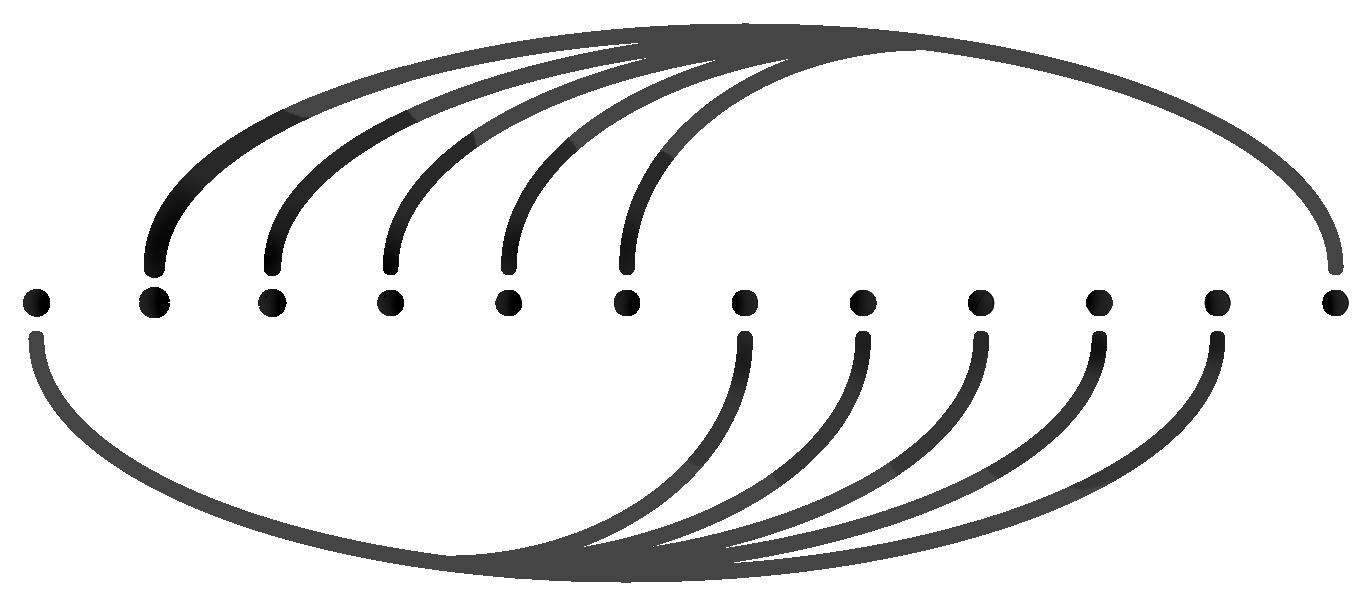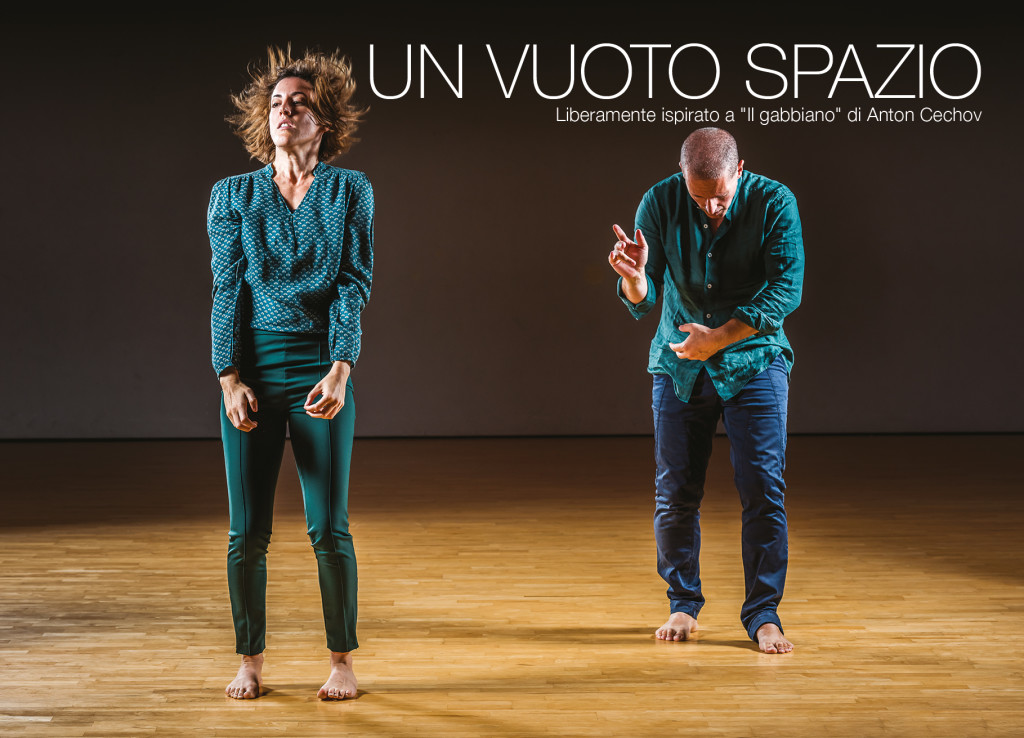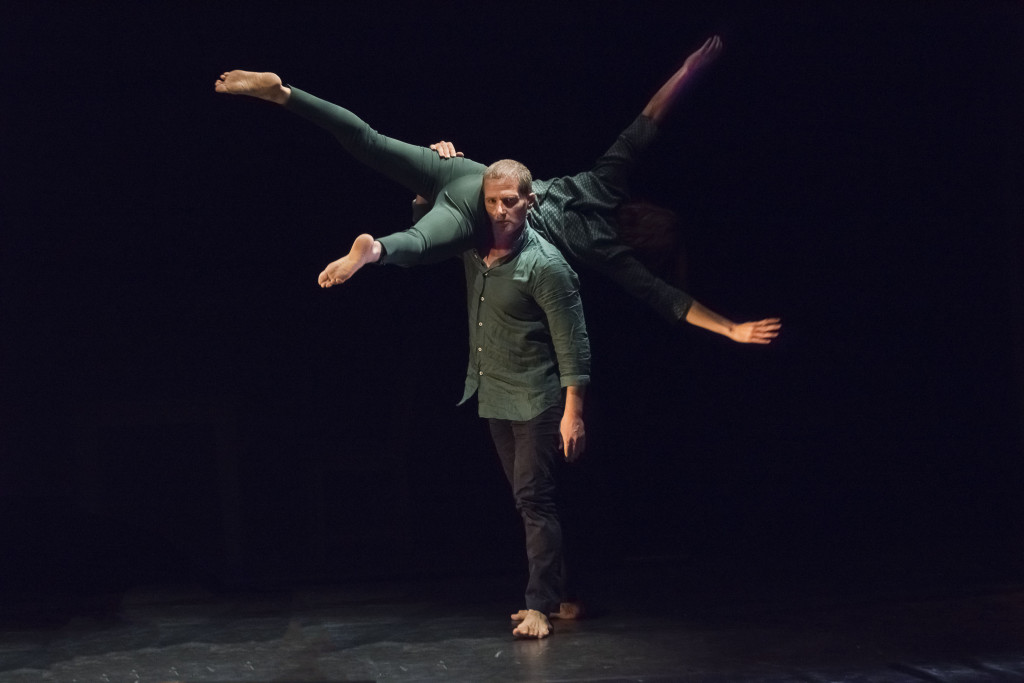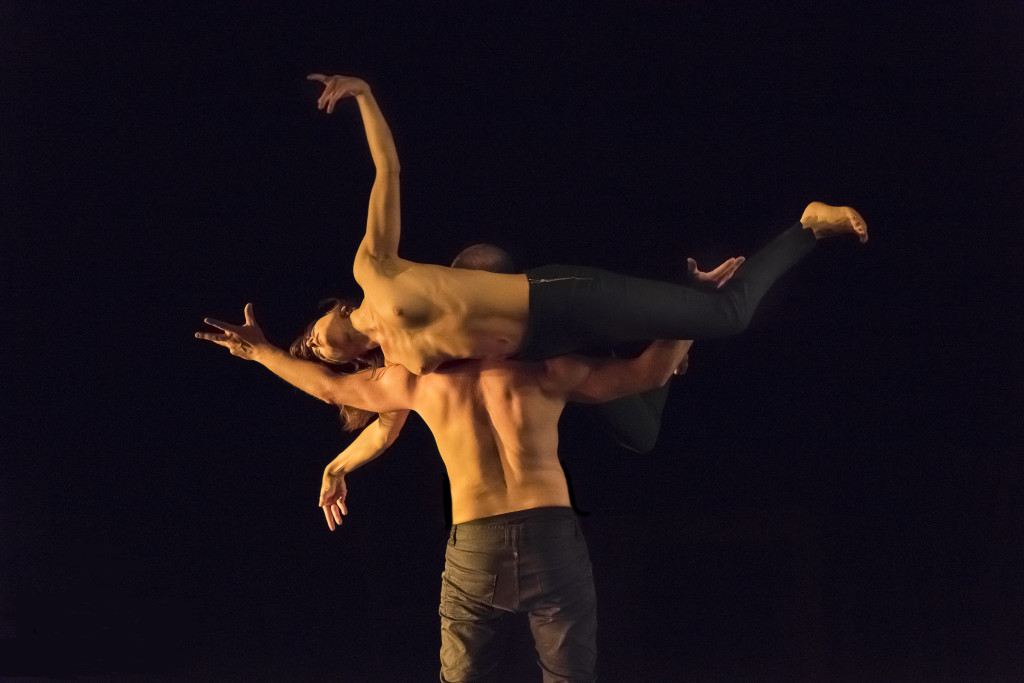UN VUOTO SPAZIO
UN VUOTO SPAZIO
(liberamente ispirato a “Il gabbiano”, di Anton Cechov)
Ideazione e coreografia: Giuseppe Asaro
Regia: Luca Spadaro
Danzatori: Giuseppe Asaro e Francesca Sproccati
Foto: Tosi-Photography
Un Vuoto Spazio nasce dall’esigenza di relazionarsi con l’altro (Duetto) , per mettere in scena uno stato profondo dell’anima che non avra’ mai una risposta se non l’atto creativo in sé.
L’unica verita’ è quella del corpo, Trepliov nel Gabbiano si uccide per eliminare il corpo in modo tale da porre fine al dramma di non essere amato, ogni personaggio creato da Checov nel Gabbiano ci mostra delle sfaccettature sottili e profonde del nostro stato d’animo in relazione con l’altro.
Come puo’ tutto questo risolversi in una danza, lasciando che sia il corpo a raccontare e non i fatti o le parole?
Due danzatori, uno spazio vuoto,un tavolo e due sedie separati da un telo che delimita le due differenti realtà.
Questi sono gli elementi concreti con cui si racconterà la storia.
Due corpi in movimento, due soli personaggi: Lui e Lei (il figlio e la madre, il fratello e la sorella, gli innamorati, gli amanti, colui che guarda e colei che si nasconde, il regista e l’attrice) in un fluido alternarsi di relazioni.
Non si tratta di un gioco in cui “si dice il Gabbiano senza usare le parole”. Si vedrà quello che di solito è nascosto, cercando di tradurre la commedia in una danza, tradendo l’originale nel tentativo di rimanergli fedele.
Da alcuni anni Giuseppe Asaro e Luca Spadaro stanno sperimentando la possibilità di un incontro creativo sul confine delle rispettive arti: da un lato la danza, dall’altro il teatro di prosa, in mezzo lo spazio per costruire una storia a partire dal corpo.
UN VUOTO SPAZIO (An Empty Space)
(freely inspired by The Seagull by Anton Cechov)
Concept and choreography: Giuseppe Asaro
Director: Luca Spadaro
Dancers: Giuseppe Asaro and Francesca Sproccati
Photo: Tosi-Photography
“UN VUOTO SPAZIO” springs from the need to relate to each other (Duet), to stage a deep state of the soul that will never have a reply but the creative act itself.
The only truth is the body’s, Trepliov, in the Seagull, kills himself to get rid of the body so as to end the tragedy of not being loved, every character created by Checov in the Seagull shows us various subtle and revealing facets of our soul when relating to each other.
How can all this resolve into a dance, thus letting the body, and not facts or words, do the telling?
Two dancers an empty space, a table and two chairs, divided by a veil marking the two different realities.
These are the two factual elements used to tell the story.
Two moving bodies, two ( universal) characters: He and She (son and mother, brother and sister, lovers, beholder and beheld, director and actress) in a fluid turnover of relationships.
It’s not about “saying the Seagull without using words”. It’s about seeing what is usually hidden, trying to translate comedy into a dance, betraying the original in an attempt to be loyal to it.
For a few years, Giuseppe Asaro and Luca Spadaro have been experimenting on the possibility of a creative encounter on the edge of their respective arts: dance on one side, drama on the other and space in the middle, to make up a story, originating in the body.
UN VUOTO SPAZIO (EIN LEERER RAUM)
(frei nach “Die Möwe” von Anton Tschechow)
Idee und Choreographie: Giuseppe Asaro
Regie: Luca Spadaro
Tänzer: Giuseppe Asaro, Francesca Sproccati
Foto: Tosi-Photography
“ Un Vuoto Spazio” entspringt dem Bedürfnis, sich mit dem Anderen zu verbinden (Duett), um einen tiefgründigen Seelenzustand darzustellen, der nie eine Antwort haben wird, wenn nicht die des kreativen Aktes in sich selbst.
Die einzige Wahrheit ist die des Körpers. Im Stück “Die Möwe” begeht Treplev Selbstmord, um den Körper auszumerzen und so dem Drama des Nicht-Geliebt-Werdens ein Ende zu setzen. Jede von Tschechow kreierte Figur in “Die Möwe” zeigt uns die subtile und tiefgründige Vielschichtigkeit unseres Seelenzustandes in Beziehung zum Anderen.
Wie kann sich all das in Tanz auflösen – wie dem Körper das Erzählen überlassen und nicht den Ereignissen und Worten ?
Zwei Tänzer, ein leerer Raum, ein Tisch und zwei Stühle, von einem Vorhang getrennt der die zwei Wirklichkeitsebenen abgrenzt – konkrete Elemente in denen sich die Geschichte abspielt.
Zwei Körper in Bewegung, zwei einzige Figuren: Er und Sie (der Sohn und die Mutter, der Bruder und die Schwester, die Verliebten, die Geliebten, Er der schaut und Sie die sich verbirgt, der Regisseur und die Schauspielerin) in einem wechselnden Fluss der Beziehungen.
Es geht nicht um ein Spiel in dem “die Möwe genannt wird ohne die Worte zu benutzen”. Es geht vielmehr darum das sonst Verborgene hervorzuholen, die Komödie in Tanz umzusetzen, das Original “zu verraten” im Versuch ihm treu zu bleiben.
Seit einigen Jahren experimentieren Giuseppe Asaro und Luca Spadaro mit der Möglichkeit einer kreativen Begegnung zwischen den zwei Kunstformen: auf der einen Seite der Tanz, auf der anderen das Prosatheater, in der Mitte der Raum, um eine Geschichte vom Körper ausgehend zu gestalten.
UN VUOTO SPAZIO ( UN VIDE ESPACE )
(Librement inspiré par “La mouette”, d’ Anton Tchekhov)
Conception et chorégraphie : Giuseppe Asaro
Metteur en scène: Luca Spadaro
Danseurs : Giuseppe Asaro e Francesca Sproccati
Photo: Tosi-Photography
“UN VUOTO SPAZIO” naît de l’exigence de se mettre en relation avec l’autre (Duo), afin de mettre en scène un état profond de l’âme qui n’aura jamais de réponse sinon l’acte créatif lui-même.
La seule vérité est celle du corps. Dans La mouette Trepliov se suicide de façon à éliminer son propre corps et en finir avec le drame de ne pas être aimé. Chaque personnage créé par Tchekhov dans La Mouette nous montre des facettes subtiles et profondes de notre état d’âme en relation avec autrui.
Comment est-ce que tout cela peut se résoudre dans une danse ? En laissant que ce soit le corps à raconter et non pas les faits ou les mots ?
Deux danseurs, un espace vide, une table et deux chaises séparées par une toile qui définit les deux réalités. Avec ces éléments concrets on va raconter l’histoire.
Deux corps en mouvement, seulement deux personnages : Lui et Elle (le fils et la mère, le frère et la sœur, les amoureux, les amants, celui qui regarde et celle qui se cache, le metteur en scène et l’actrice) dans un aller-retour fluide de relations qui se balancent.
Il ne s’agit pas d’un jeu dans lequel « l’on dit la Mouette sans utiliser les mots ». On verra ce qui normalement est caché, en cherchant à traduire la comédie dans une danse, en trahissant l’original tout en essayant de lui rester fidèle.
Depuis quelques années, Giuseppe Asaro et Luca Spadaro expérimentent la possibilité d’une rencontre créative à la frontière des arts respectifs : d’un côté la danse, de l’autre le théâtre, et au milieu l’espace pour construire une histoire à partir du corps.
UN GABBIANO CHE DANZA
Dal repertorio classico, moderno e contemporaneo si assiste a un continuo travaso di reciproca empatia fra il teatro e la danza: un rapporto complesso, rispettoso, delicato e sinuoso. Può apparire una sfida se un regista teatrale viene chiamato a firmare la messa in scena di uno spettacolo di danza. Ne è però valsa la pena per Un vuoto spazio, spettacolo in prima assoluta al Teatro Sociale di Bellinzona e liberamente ispirato a Il gabbiano di Cechov.
Un’idea coreografica di Giuseppe Asaro in scena con Francesca Sproccati. Inizio molto fisico in cui i due protagonisti si presentano in proscenio invocando un rituale individuale di movimenti ripetuti, come cercando di liberarsi di qualcosa. Gli ambienti musicali e sonori sono ipnotici, lontani e profondi al medesimo tempo, evocatori di spazi e memoria. Per i due personaggi inizia una trama di incontri, di contatti svelati o intimi, come quelli resi dietro a un velario dove un tavolo e due sedie creano la parentesi domestica.
Suggestioni teatrali di Spadaro come i tagli di luce, ora caldi ora accennati, fra sospensioni e cambi d’accento sui movimenti: allusioni a una storia dove immaginiamo la Nina di Cechov, ora con Treplëv ora con Trigorin in un amore il cui il movimento dei corpi è in un continuo equilibrio fra contatti giocati sulla leggerezza. Riconoscervi la commedia di Cechov non è scontato, conoscerne la storia può però fornire indicazioni. Come in alcune azioni ripetute dove gli amanti si attraggono e si respingono in un loop di ripetizioni (talvolta eccessive) per un sottinteso drammatico. O come l’intreccio delle braccia in un estremo battito di ali (il gabbiano).
Lo spettacolo termina sulla falsariga del suo esordio con i danzatori che rievocano i loro primi movimenti, ma a vivere, seppur disperatamente, c’è solo Nina. Di lui non ci resta che un’espressione fissa, ormai spenta. Una prova intensa e affiatata di Francesca Sproccati e Giuseppe Asaro per uno spettacolo riuscito nell’incontro creativo tra l’idea coreografica e la sostanza teatrale.
Settimanale AZIONE 07.11.2016
di Giorgio Thoeni
A DANCING SEAGULL
From a classic, modern and contemporary repertory, a continuous flow of mutual understanding between theatre and dance can be witnessed. It is a relationship that is complex, respectful, delicate and sinuous. It may seem challenging for a theatre director to be asked to sign up to the staging of a dance show. However, this proved to be worthwhile for An Empty Space, a show that debuted at Bellinzona’s Teatro Sociale and was loosely inspired by Cechov’s The Seagull.
The idea was proposed by Giuseppe Asaro, who appears alongside Francesca Sproccati. The beginning is very physical and the two leading characters come into view on the forestage invoking individual rituals of repetitive movements, as if they are trying to free themselves of something. The music and sounds used are hypnotic, both distant and profound at the same time, recalling spaces and memory. At the beginning, the characters experience a series of revealing and intimate encounters, such as those behind a curtain where a table and two chairs create a domestic setting.
Spadaro’s theatrical input such as lighting, at times warm, at others suffused, use of suspensions and change of stress on movements, allude to a story in which Cechov’s Nina seems to be in love, at times with Treplëv at others with Trigorin. The movements of their bodies are in continuous balance between touches that are executed lightly. Whilst being able to recognise Cechov’s play is not assumed, having previous knowledge of the story can help. This can be observed, for example, in the repetitive actions in which the two lovers are attracted to each other and then push each other away in a loop of repetitions (which are at times excessive) for dramatic effect. This can also be seen in the intertwining arms in an extreme beating of wings by the seagull.
The performance finishes along the same lines as the beginning, with the dancers repeating the same movements. However, the only one who survives, albeit desperately, is Nina. The male character only offers a fixed facial expression, which is lifeless. The close and intense performance by Francesca Sproccati and Giuseppe Asaro ensures a successful show that creatively combines choreography and the essence of theatre.
From the weekly magazine Azione, 7.11.16
Original Text by Giorgio Thoeni
“UN VUOTO SPAZIO” è stato selezionato alla Borsa Svizzera degli Spettacoli il 21-22-23 Aprile 2017 a THUN
Watching Video 20 minute short version




